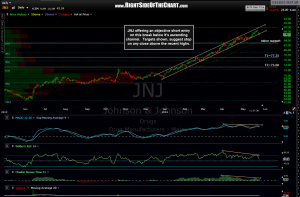 JNJ is one more in a long list of blue-chip, dividend stocks that has the potential for a longer-term swing short trade. Why would someone want to short such as solid company with an attractive dividend and one of the top 5 components of the S&P 500? Simple: just like AAPL back when I added it as a long-term short trade on August 24th, as the most beloved stock since the South Sea Company was making all-time highs and all the analysts were in a frenzied game of leap-frog to one-up the last guy’s ridiculous price target, JNJ, like AAPL back then, is simply over-loved and over-owned.
JNJ is one more in a long list of blue-chip, dividend stocks that has the potential for a longer-term swing short trade. Why would someone want to short such as solid company with an attractive dividend and one of the top 5 components of the S&P 500? Simple: just like AAPL back when I added it as a long-term short trade on August 24th, as the most beloved stock since the South Sea Company was making all-time highs and all the analysts were in a frenzied game of leap-frog to one-up the last guy’s ridiculous price target, JNJ, like AAPL back then, is simply over-loved and over-owned.
As an added kicker, there’s a pattern, or similarity I should say, to the recent almost unnatural looking ramp in JNJ’s stock price since mid-2012. I pointed out a nearly identical price pattern on the CMG short last year as one of the reasons for shorting that over-loved, extremely bullish looking (to the wrong eyes, that is) stock. CMG was added as a short entry on April 20, 2012, just four days after the stock peaked at an all-time high. The stock went on to get cut in half from that point (50%~ drop) and here’s one of the several weekly charts posted back then pointing out that unnatural price behavior (which I believe to be the result of computer algorithm-driven programmed trading engineered to keep a persistent bid under a high-short interest stock in order to painfully & systematically squeeze just about every last short out of the stock, although that is just a theory).
Now the problem with that is once most of the short interest in a stock is wiped (squeezed) out, an imbalance between potential buyers and sellers emerges. A stock (or market) with an unusually low short interest is lacking the typical pool of the only guaranteed buyers of that stock. You see, a bull who likes JNJ and is considering buying the stock may or may not step in to buy it at some point in the future. In fact, I’ll bet that if this market dropped by over 15% in the next couple of months that a very large portion of those bullish traders looking to buy JNJ might begin to second guess their stance on the market and that stock and decide not to step in and buy. Those short JNJ on the other hand, must buy the stock at some point in the future in order to close out their open positions. This is why stocks with a high short-interest often find a floor on pullbacks or may even continue to rise despite very poor fundamentals while stocks with an extremely low short are lacking a natural floor, or supply of guaranteed buyers.
As far as position sizing, I often talk about adjusting down a position on trades that either are experiencing high volatility or have a history of large price swings. The flip side to that would be these recently blue-chip shorts such as JNJ, K, CVX & PM which tend to move inline with the broad markets in both direction and scope as these type of stocks might warrant a full or even above average position size. Keep in mind that this is only one factor in determining your position size. Your overall current preferred long or short exposure should also be factored in (e.g.- a trader might want to be around 50% net short right now, moving up to 75% net short if XX support level breaks) as well as your overall risk tolerance and experience level (those new to trading or investing should rarely, if ever, be 100% net long or 100% net short).



